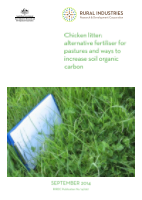Rising costs of conventional fertilisers has led broadacre livestock producers (wool, lamb, beef) to seek alternative nutrient sources to fertilise pastures and crops. Spent litter from meat chicken sheds is a viable alternative, particularly when key inputs like phosphorus fertiliser prices are very high, or where a range of macro nutrients and trace elements are required
The project was therefore undertaken to produce information that will assist livestock producers to successfully utilise litter on pastures in a cost-effective manner. It was also intended that the project will serve to increase awareness of chicken litter as an alternative source of nutrients and an ameliorant for poor soils by improving soil organic matter and carbon. A method for valuing the organic matter in litter, in addition to the nutrients, was also developed in the course of the project, based on the increases in soil organic carbon measured in the field experiments undertaken.
The project has and will continue to benefit livestock producers by providing them with objective data, practical information and demonstrations on how to utilise litter as an alternative fertiliser and how to value the nutrients relative to conventional fertilisers. The chicken meat industry will also benefit from the project through increased awareness of the product amongst livestock producers across south-eastern Australia. This will drive further demand for litter and create a more steady market which will benefit chicken meat producers and shed clean-out/cartage/spreading contractors.





